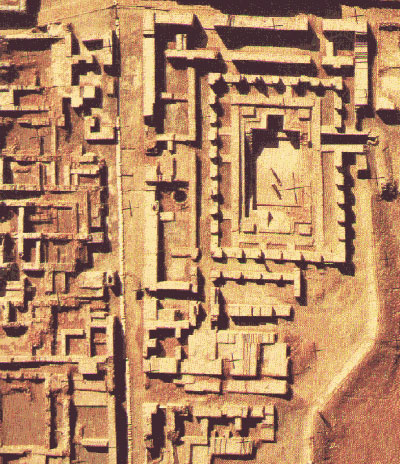ghazi52
PDF THINK TANK: ANALYST

- Joined
- Mar 21, 2007
- Messages
- 102,847
- Reaction score
- 106
- Country
- Location
..Indus . . . ..
.
What Were Indus Cities Like?

An Indus city was made of mud-brick buildings. It had walls and roads. Water was very important to Indus people, so the builders started by digging wells, and laying drains. Main streets were up to 10 metres wide, wide enough for carts to pass. Side streets were narrow, more like alleys.

Some cities had a citadel high on a mound. In the citadel were bigger buildings. Perhaps the city's rulers lived there. Most people lived and worked in the lower part of town. Most Indus people did not live in cities at all. Perhaps 9 out of 10 people were farmers and traders who lived in small villages.
_
Was There An Indus Empire?

An empire is a large country or group of countries, with different peoples ruled by a king or emperor. The Indus Valley civilisation was very large, but we do not know if it had kings. It seems that nothing much changed there for hundreds of years. New houses were built on top of old ones, and city street plans stayed the same. Life went on in the same way for generations. This might mean the Indus rulers controlled everything. Or it might just mean they were happy the way things were. What look like crowns were found at a site called Kunal. Did they belong to an Indus king? Perhaps each city had its own ruler.
Did Indus cities have soldiers?
An Indus city had strong walls, and in history, walls usually mean people want to keep out enemies. Think of a medieval castle. Like a castle, an Indus city had towers and gateways, but we do not know if there were soldiers. At the city gates city officials could check traders coming in and out. There were probably guards too, in case of trouble.
Other ancient civilisations, such as Egypt, had large armies. Kings fought battles with enemies. But the Indus people seem to have lived in peace for most of their history. Other ancient writings tell us about wars. Since we can't yet read the Indus writing, we just don't know.

_
Indus gods

Pictures on seals and other artifacts show what look like figures of gods. One looks like a Mother Goddess. People probably believed this goddess gave health and fertility to people, animals and plants.

Another seal picture shows a male god with horns and three faces. Around him are animals, including an elephant, tiger, rhino and buffalo. Plants, trees and animals were probably important to Indus people.
.
What Were Indus Cities Like?

An Indus city was made of mud-brick buildings. It had walls and roads. Water was very important to Indus people, so the builders started by digging wells, and laying drains. Main streets were up to 10 metres wide, wide enough for carts to pass. Side streets were narrow, more like alleys.

Some cities had a citadel high on a mound. In the citadel were bigger buildings. Perhaps the city's rulers lived there. Most people lived and worked in the lower part of town. Most Indus people did not live in cities at all. Perhaps 9 out of 10 people were farmers and traders who lived in small villages.
_
Was There An Indus Empire?

An empire is a large country or group of countries, with different peoples ruled by a king or emperor. The Indus Valley civilisation was very large, but we do not know if it had kings. It seems that nothing much changed there for hundreds of years. New houses were built on top of old ones, and city street plans stayed the same. Life went on in the same way for generations. This might mean the Indus rulers controlled everything. Or it might just mean they were happy the way things were. What look like crowns were found at a site called Kunal. Did they belong to an Indus king? Perhaps each city had its own ruler.
Did Indus cities have soldiers?
An Indus city had strong walls, and in history, walls usually mean people want to keep out enemies. Think of a medieval castle. Like a castle, an Indus city had towers and gateways, but we do not know if there were soldiers. At the city gates city officials could check traders coming in and out. There were probably guards too, in case of trouble.
Other ancient civilisations, such as Egypt, had large armies. Kings fought battles with enemies. But the Indus people seem to have lived in peace for most of their history. Other ancient writings tell us about wars. Since we can't yet read the Indus writing, we just don't know.

_
Indus gods

Pictures on seals and other artifacts show what look like figures of gods. One looks like a Mother Goddess. People probably believed this goddess gave health and fertility to people, animals and plants.

Another seal picture shows a male god with horns and three faces. Around him are animals, including an elephant, tiger, rhino and buffalo. Plants, trees and animals were probably important to Indus people.





